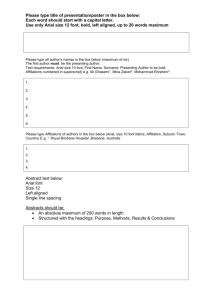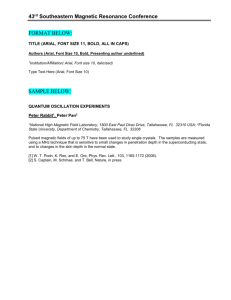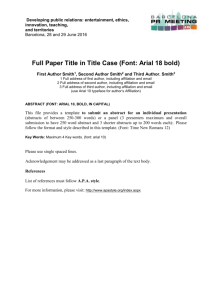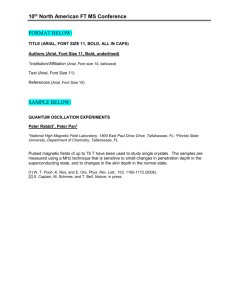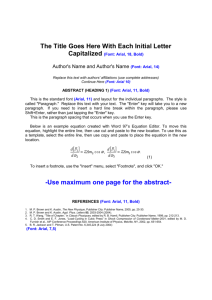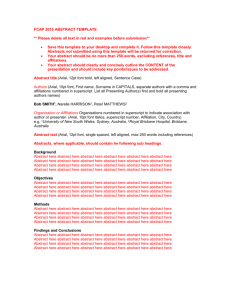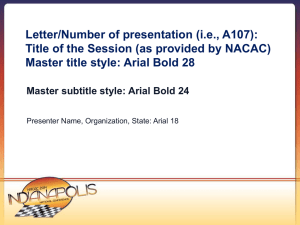the MS word template
advertisement
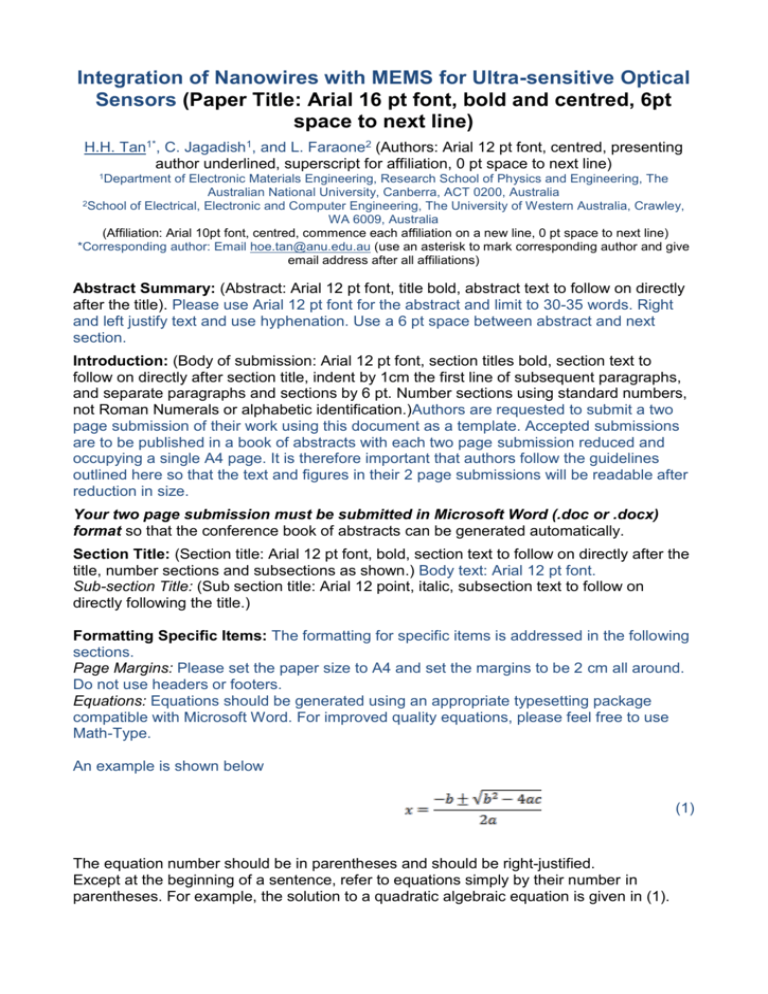
Integration of Nanowires with MEMS for Ultra-sensitive Optical Sensors (Paper Title: Arial 16 pt font, bold and centred, 6pt space to next line) H.H. Tan1*, C. Jagadish1, and L. Faraone2 (Authors: Arial 12 pt font, centred, presenting author underlined, superscript for affiliation, 0 pt space to next line) 1Department of Electronic Materials Engineering, Research School of Physics and Engineering, The Australian National University, Canberra, ACT 0200, Australia 2School of Electrical, Electronic and Computer Engineering, The University of Western Australia, Crawley, WA 6009, Australia (Affiliation: Arial 10pt font, centred, commence each affiliation on a new line, 0 pt space to next line) *Corresponding author: Email hoe.tan@anu.edu.au (use an asterisk to mark corresponding author and give email address after all affiliations) Abstract Summary: (Abstract: Arial 12 pt font, title bold, abstract text to follow on directly after the title). Please use Arial 12 pt font for the abstract and limit to 30-35 words. Right and left justify text and use hyphenation. Use a 6 pt space between abstract and next section. Introduction: (Body of submission: Arial 12 pt font, section titles bold, section text to follow on directly after section title, indent by 1cm the first line of subsequent paragraphs, and separate paragraphs and sections by 6 pt. Number sections using standard numbers, not Roman Numerals or alphabetic identification.)Authors are requested to submit a two page submission of their work using this document as a template. Accepted submissions are to be published in a book of abstracts with each two page submission reduced and occupying a single A4 page. It is therefore important that authors follow the guidelines outlined here so that the text and figures in their 2 page submissions will be readable after reduction in size. Your two page submission must be submitted in Microsoft Word (.doc or .docx) format so that the conference book of abstracts can be generated automatically. Section Title: (Section title: Arial 12 pt font, bold, section text to follow on directly after the title, number sections and subsections as shown.) Body text: Arial 12 pt font. Sub-section Title: (Sub section title: Arial 12 point, italic, subsection text to follow on directly following the title.) Formatting Specific Items: The formatting for specific items is addressed in the following sections. Page Margins: Please set the paper size to A4 and set the margins to be 2 cm all around. Do not use headers or footers. Equations: Equations should be generated using an appropriate typesetting package compatible with Microsoft Word. For improved quality equations, please feel free to use Math-Type. An example is shown below (1) The equation number should be in parentheses and should be right-justified. Except at the beginning of a sentence, refer to equations simply by their number in parentheses. For example, the solution to a quadratic algebraic equation is given in (1). Tables and Figures: Refer to tables or figures in the text using the form Table 1 or Fig. 1 (i.e. capitalise the word Table or Figure and do not abbreviate “Table”, but do abbreviate the word “Figure”). Tables and figures must be numbered and have descriptive captions. An example of a table is given in Table 1, and that of a figure in Fig. 1. Table 1: An example table. Table Font Use Arial 10pt font in tables Caption Caption should be Arial 10 pt font, indented 0.5 cm from the margin and above the table. References: Number citations consecutively within brackets [1]. The sentence punctuation follows the bracket [2]. Refer simply to the reference number, as in [3]. The formatting for the actual citations is given below. Acknowledgements (Arial 12 pt font, bold and left justified) This work has been supported by the Australian Research Council under DP1000090 and DARPA under contract XYZ. The acknowledgement title should be Arial 12pt, bold and left justified. The text should be Arial 10 point. References (Arial 12 pt font, bold and left justified) Citations should be written in Arial 10pt font. Papers that have not been published, even if they have been submitted for publication, should be cited as “unpublished” [4]. Papers that have been accepted for publication should be cited as “in press” [5]. Capitalize only the first word in a paper title, except for proper nouns and element symbols. [1] [2] [3] [4] [5] [6] G. Eason, B. Noble, and I. N. Sneddon, “On certain integrals of Lipschitz-Hankel type involving products of Bessel functions,” Phil. Trans. Roy. Soc. London, vol. A247, pp. 529–551, April 1955. (references) J. Clerk Maxwell, A Treatise on Electricity and Magnetism, 3rd ed., vol. 2. Oxford: Clarendon, 1892, pp.68–73. I. S. Jacobs and C. P. Bean, “Fine particles, thin films and exchange anisotropy,” in Magnetism, vol. III, G. T. Rado and H. Suhl, Eds. New York: Academic, 1963, pp. 271–350. K. Elissa, “Title of paper if known,” unpublished. R. Nicole, “Title of paper with only first word capitalized,” J. Name Stand. Abbrev., in press. Y. Yorozu, M. Hirano, K. Oka, and Y. Tagawa, “Electron spectroscopy studies on magneto-optical media and plastic substrate interface,” IEEE Transl. J. Magn. Japan, vol. 2, pp. 740–741, August 1987 [Digests 9th Annual Conf. Magnetics Japan, p. 301, 1982]. Fig. 1. The figure caption should be Arial 10pt and indented 0.5 cm.
